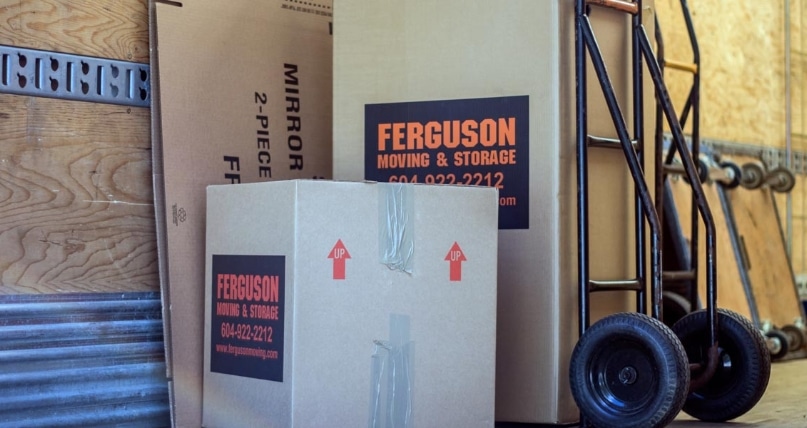
If you’re planning on moving on Vancouver Island, Ferguson Movers and Storage can help you execute your move. You can rely on our decades of experience with long distance moving and take the headache out of moving. Our non commissioned moving planners can help you plan your move so that everything goes smoothly and according to a structured plan.
Ferguson Moving and Storage is pleased to assist you in your moving needs all across Vancouver Island. We specialize in safely moving our customers valuable furniture and keepsakes to their new home.
Ferguson Moving and Storage are the moving company specialists across Vancouver Island. We offer a free moving quote so you can budget for your moving expenses. Ferguson Moving and Storage knows that moving is a stressful time in peoples lives and we are there to help make your move easier. Contact us for your free moving estimate and take the worry and hassle out of moving. We are one of BC’s oldest and most reliable movers, established way back in 1916.
VANCOUVER ISLAND, BRITISH COLUMBIA
LOCATION
Vancouver Island BC, is the largest island on the west Coast of North America, it’s nearly 460 km long and 50-80 km
wide and stretches parallel to the British Columbia mainland. The Island is separated from mainland
Canada by the Georgia, Queen Charlotte, and Johnstone straits, and from the U.S. by Juan De Fuca
Strait. Along with the Queen Charlotte Islands, it forms part of a partially submerged chain of the
Cordillera and is a continuation of the U.S. coastal mountains.
Vancouver Islands’ coastline is very rugged, especially on the west where there are several fjord-like
inlets, the longest being Alberni Inlet and Muchalat Inlet, that cut into a heavily forested, mountainous
interior, with mountains averaging 600-1,000 m. Higher peaks include Golden Hinde (2,200 m), Elkhorn
Mountain (2,194 m) and Mount Colonel Foster (2,133 m). In contrast to this mountainous core are the
coastal lowlands, which form an almost encircling belt. They are most pronounced in the north and east
where the Nahwitti and Nanaimo lowlands form part of a coastal trough stretching from southeast Alaska
to the Puget Depression in Washington State.
The Island has numerous freshwater lakes, the largest being Nimpkish, Cowichan, Buttle, Sproat, Great
Central, and Campbell. The climate is damp but mild, with precipitation ranging from 3.8 m in the
western flanks of the mountains to less than 0.8 m in the southeast Nanaimo Lowland. Much of the
precipitation returns to the Pacific through a series of rapid-flowing, deeply incised, relatively short
rivers, such as the Nanaimo and Campbell. The Island is most heavily populated in the southeast, where
the City of Victoria is located.
HISTORY
First Nation people have occupied the Island for several thousand years. A tribal village society evolved,
with an economy based on fishing, collecting, and hunting. The abundant marine and forest resources
along the coasts supported a culture rich in oral tradition and artistic expression. Two main linguistic
families, Salishan and Wakashan, developed and continue to exist. In the early 19th century the native
population was about 15,000. Owing to disease, it declined to about 5,600 in 1881, fluctuated around
5,000 until the 1950s, but increased to more than 7,000 by the 1970s.
The diversity of place-names with which the Island and its surrounding islands and waters abound, are a
permanent record of its exploratory period. The voyage of James Cook, and George Vancouver’s
circumnavigation and hydrographic survey of the Island (1792-94) provided the basis for increased
British penetration. In 1843, the HBC sent James Douglas to the Island to select a site for a fort, and a
small settlement at the southern tip developed around Fort Victoria. The Treaty of Washington (1846)
established the Island as British territory; it was made a British crown colony in 1849. It united with the
mainland British Columbia colony in 1866 and the united colony entered the Dominion of Canada as the
province of British Columbia in 1871.
VANCOUVER ISLAND, BRITISH COLUMBIA
HISTORY (CONT)
The European population grew slowly until the 1860s, when the discovery of gold on the mainland and
coal on the Island led to a significant increase. Some of those disappointed in the goldfields turned to
farming and coal mining and joined a growing trickle of settlers carving out homesteads on the narrow
eastern lowlands. Besides Victoria, early settlement centered on the Duncan area of the Cowichan River
valley and the Courtenay-Comox region, both attractive and fertile valleys.
Although the forest was an obstacle to the pioneer farmer, its sheer quantity and high quality stimulated
the growth of lumber mills at points accessible to tidewater, such as Port Alberni (1861) and Chemainus
(1862). The Esquimalt and Nanaimo Railway (1886) provided the basis for expanding the Island’s
lumber and mining industries. By 1900, the population had grown to around 51,000, with nearly 90%
concentrated in the Victoria-Nanaimo region.
After 1900, the pace of development increased rapidly as immigration continued and the mining and
lumbering industries developed. Nanaimo expanded and new coal mines were opened at Cumberland,
Ladysmith, and Union Bay. Population growth slowed down between 1921 and 1941, as little suitable
land for agricultural development remained; the exhaustion of the best coal deposits left further
development to the expansion of the forest industry. The potential for tourism was also becoming
apparent as transportation facilities improved, and as the attraction of the Island as a retirement area
grew.
TODAY
The postwar era saw a new surge of growth associated with the increased activity of the forest-products
industry, with new or expanded mills at Port Alberni, Crofton, Campbell River and Gold River. The
province also became more actively involved in developing and managing the economy, and Victoria,
the capital, benefited from expanded government functions. Recent elements of growth have been
highway and hydroelectric-power construction, modernization of the ferry system, expansion of military
bases and the continued growth of tourism.
The population of Vancouver Island is approximately 740,8760 with the majority of the Island’s residents
living in Greater Victoria, Duncan, Nanaimo, Port Alberni, Courtenay, Campbell River and then
numerous small towns and villages.
For more information about Vancouver Island visit their websites at
www.vancouverislandbritishcolumbia.com and www.vancouverisland.com.
RECREATION
Vancouver Island Regional Library
90 Commercial St.
Nanaimo, BC
V9R 5G4
(250) 758-4697
www.virl.bc.ca
VANCOUVER ISLAND, BRITISH COLUMBIA
MEDICAL SERVICES
Vancouver Island Health Authority
1952 Bay St.
Victoria, BC
V8R 1J8
(250) 370-8699
www.viha.ca
EMERGENCY TELEPHONE NUMBERS
*Please confirm these emergency numbers when you arrive in your new community.
AMBULANCE …………………………………………… 911
FIRE ………………………………………………………….. 911
POLICE …………………………………………………….. 911
PUBLIC SERVICES
Hydro: B.C. Hydro …………………………………………………………….1-800-224-9376
Website ………………………………………………………….. www.bchydro.com
Gas: FortisBC ………………………………………………………………. 1-888-224-2710
Website …………………………………………………………….. www.fortisbc.com
Telephone: Telus (outside BC) …………………………………………………. 1-888-811-2323
Telus (within BC) ……………………………………………………………. 310-2255
Website …………………………………………………………………. www.telus.com
The telephone area code for Vancouver Island is 250.
TRANSPORTATION
Driver and Vehicle Licenses -ICBC ……… 1-800-950-1498
BC Transit ………………………………………… (250) 382-6161
Website ………………………………………… www.transitbc.com
BC Ferries ………………………………………… 1-888-223-3779
Website ……………………………………….. www.bcferries.com
WELCOME WAGON
Since although effect is increasing, so does the side effects, including headaches and also the rapid onset of addiction.
Welcome Wagon is a free service to help you get acquainted with y our new community by
providing valuable information about your new area and gifts from local merchants.

Categories
Moving Tips

This is the heading
Lorem ipsum dolor sit amet, consectetur adipiscing elit. Ut elit tellus, luctus nec ullamcorper mattis, pulvinar dapibus leo.

This is the heading
Lorem ipsum dolor sit amet, consectetur adipiscing elit. Ut elit tellus, luctus nec ullamcorper mattis, pulvinar dapibus leo.
We make moves easy for you.
- Local Moving
- Long Distance Moving
- Seniors Moving
- Piano Moving
- Item Relocation
- Overnight and Long-term Storage
- Packing Supplies





